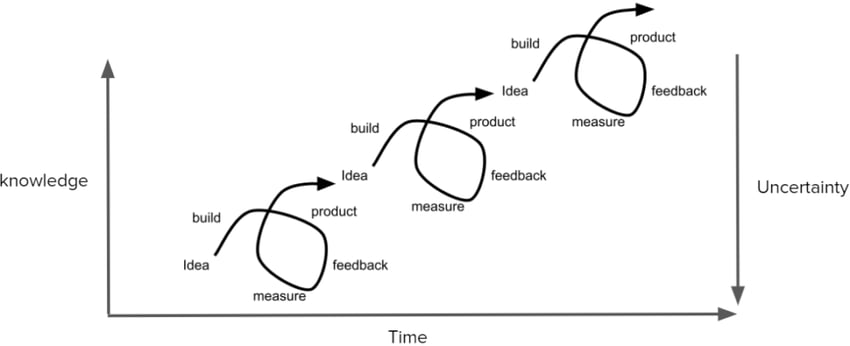Reducing Risk

This is the third blog in our Lean Startup Methodology blog series. In this blog series, we go over Lean Startup Methodology principles and show how these help startup founders tackle a variety of risks they face in each step of their startup journey. In the first blog, we started with defining what a startup is, and what the steps defined in the lean startup methodology are. In the second blog, we listed different types of risks a startup faces and how the lean startup methodology can help overcome them. Here, we discuss the problem risk, how founders should focus on solving the biggest problems their customers have first, and why it is so important to validate the problem, by validating customers and interviewing them. Also, it is important to focus on “early adopters” in the early stages to reduce the market risk.
Reducing Problem Risk
By fundamentally shifting from the old way of operation to innovating and changing parts of the business model, founders should adapt to better serve their customers. The question to ask about a new solution is:
Is it solving one of the biggest problems of your target customer?
If the customer has bigger problems, founders should focus on solving those problems first. It’s a much harder sell to solve secondary problems. For example, selling digital menu solutions for restaurants. A startup can only sell this to busy restaurants, otherwise they have a bigger problem to solve first, finding customers.
Indicators of a Valid Problem
How does a startup founder validate the problem they are trying to solve? Some questions to ask:
- Have you experienced the problem yourself, personally (B2C) or in a business (B2B)?
- Can you explain the problem in a short sentence?
By identifying existing solutions as time-consuming, too expensive, boring, or too complicated for certain people, valid solutions may become easier to identify. Some common misconceptions are that the solution has to solve problems X, Y, Z altogether for the customers to adopt a new solution and that the problem we solve today is going to be the same one we will solve years from now.
Successful startups solve a single problem at the beginning, big enough to drive traction on their own and expand it later. Another example is Facebook, initially an exclusive social app for Harvard students, which expanded to become an exclusive social app for US post-secondary schools, only to expand to what it is today.
Problem Interviews
As a startup, you may consider using this method to hear the customer’s problems (in most cases early adopters) and then design the solution for them. Let the customer tell you the problem and you design the solution. It is important not to directly ask to validate the problem but ask for example, “What are the top three problems in your day-to-day work you wish you had a solution for?” In this process, it is important not to ask “Are you having problem X in your day-to-day work?”. (In many cases this feels like a selling strategy, and also does not help you to identify the real problem the customer has.) If the problem you are solving is not among the top problems of any customers THEY have, it’s probably not a real problem for them.
Finding the Winner
A lean startup methodology strives to reduce the time between building (e.g. the product), measuring results (from feedback), learning from previous iterations building again, and repeating. A lean startup gets into the cycle as fast as possible, knowing that each iteration reduces uncertainty.
 For the customer, the problem is one of their biggest, and they are fully aware of having the problem. They have been actively seeking a solution and may have put together a solution out of parts, and there is no better solution on the market. Ideally, they are willing to pay for a better solution and have the power to make the purchase decision.
For the customer, the problem is one of their biggest, and they are fully aware of having the problem. They have been actively seeking a solution and may have put together a solution out of parts, and there is no better solution on the market. Ideally, they are willing to pay for a better solution and have the power to make the purchase decision.
Reducing Market Risk
It is important to focus on “early adopters” in the early stages, that’s probably just ~1% of your total customers over the long run. You should clarify whose problem you are solving and who is going to pay for the solution. You will realize that it takes more effort to find these customers who are eager to try new solutions. There is no need to try solving a problem for all of your potential customers in the beginning but rather focus on the evangelists. By being patient, you could target 1,000,000 customers in 5 years, when the total market size is 100,000,000 customers. 1 out of 100 of your target customers are your early adopters. It is beneficial to be selective and segment them.
Validating Customers
By defining the target market, a startup can begin to define the customers. As an example, marketplace apps sometimes have the problem of identifying what side of the marketplace is their main customer. In some cases, the marketplace is consumer constrained. For example:
- For Uber, the customer is the driver because it is harder to find riders than drivers.
- For companies like LinkedIn, the customer is the recruiter because it is harder to find talent than finding jobs.
There are cases where the consumer is the customer. For example:
- For Airbnb (in the beginning), the renter is the customer. Supply of cheap on-demand rental was limited.
- For Spotify, the buyer is the customer. It takes time to find your favorite music.
Sometimes it’s both suppliers and consumers who are the customers. This is the case for emerging markets, like Airbnb, these days.
The startup founder should figure out if it is easier to find suppliers or consumers, and which side is in competition.
The startup should now avoid analysis paralysis and go out demonstrating the solution to customers. The sooner this is done, the better because potential customers’ opinions matter and could be much more valuable than friends or even getting investor opinions. Opinions about the product from non-potential customers don’t matter and could be misleading.
There are a couple of misconceptions the startup founder should avoid:
- I have got one chance to get in front of customers. WRONG! There is an almost infinite pool of isolated potential customers (geographically, demographically, etc.), and you can do rounds of validation with different groups. Most often you can get back to them with a different problem/solution.
- The customer I’m solving a problem for today, is going to be the same one in years to come.
Validating Solutions
In our next blog, we will focus on why it is so important to validate solutions as soon as possible, and market it first by having a landing page or registration form to do online marketing before building a product. We’ll discuss building a contact list without product, fund-raising, customer validation, and how to get a sense of customer acquisition cost.
Contact us
Learn more about how NuBinary can help your startup come to market through our Fractional CTO service, product development and more. Visit https://nubinary.com/work-with-us.



